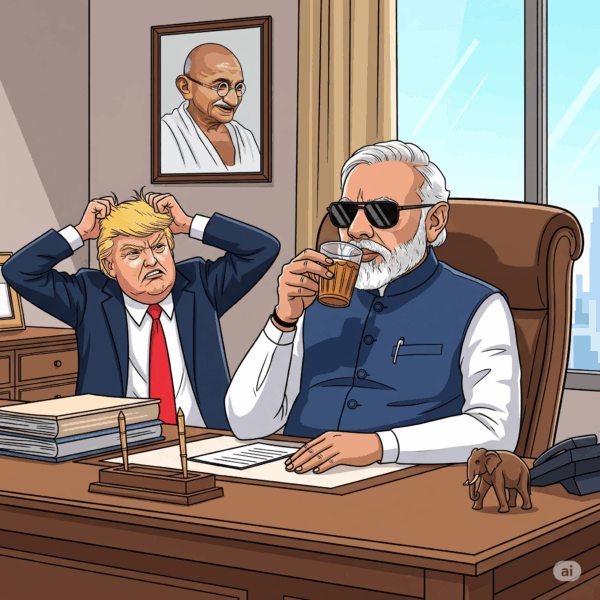A phone call that was meant to be a warning became the spark for a new geopolitical reality. When Vice President Vance called Prime Minister Modi to caution that Pakistan was ready to bomb India, Modi played it cool. The events that followed—and the public reactions from leaders like Trump—reveal why. This is the story of a shifting global balance where a new order is rapidly evolving, with BRICS nations and India at the forefront of this transformation.
The US’s Critical Miscalculation
The biggest mistake the US is making is its continued support for Pakistan, a nation that not only uses terrorism as a state weapon but is also being designated as a terrorist sponsor state. This stance shows a fundamental misunderstanding of the region, treating India and Pakistan as equals in terms of military strength, financial power, and IT capability. In the comity of nations, this should not be acceptable, and the US, a democratic nation, should not support it. By covertly supporting Pakistan until recently, and now openly, the US political leadership has landed itself in a difficult position, as the eventual return from this path will be both painful and shameful.
A Geopolitical Snapshot: Recent Events
- Munir leaves for the US.
- Putin confirms his visit to India.
- Modi’s visit to China is confirmed.
- China berates Pakistan for failing to protect its interests within Pakistan.
- Trump announces a 25% tariff, later adding another 25%.
- India stands firm on opening its agricultural and dairy markets and is refusing to yield.
- India strikes Pakistan with precision, demonstrating its war prowess.
India’s Response and Trump’s Frustration
The core of Trump’s frustration with India stems from a recent series of events. The call from Vance was a diplomatic sleight of hand. The US, which had been silent on Pakistan’s repeated terrorist attacks against India, suddenly showed anxiety over a full-blown conflict. In hindsight, it appears the goal was to set up a scenario where Trump could later claim to have stopped a war and earned a Nobel Peace Prize.

India, however, did not play along. In response to Pakistan’s indiscriminate attacks, India’s military responded with precision, blocking around 1,000 missiles and striking several airbases. The F-16s were downed as confirmed by India’s Air Force Chief, and much of America’s war support lay shattered. Faced with the prospect of another night of pin-point strikes, Pakistan’s DGMO called India’s DGMO to ask for a ceasefire.
This decisive action demonstrated India’s ability to stand independently in war, trade, and international relations. Trump’s frustration has grown significantly as a result.
Global Realignment
India’s strength and resilience are causing a significant shift in global relations:
- China, seeing India’s power, has paused its bullying tactics and opened the door to mending ties.
- Russia now perceives India as a stronger partner and is considering deeper collaborations.
- After the successful strikes, India’s political leadership has gained confidence in its defense manufacturing. It is now planning to upgrade its Su-30MkII fighters to Su-37 and has rejected the US F-35 stealth fighter, further increasing Trump’s frustration.
- Facing high tariffs, Brazil’s president has indicated plans to talk to Modi, highlighting Modi’s growing global popularity.
- Israel’s Prime Minister has suggested the US and India should resolve their differences, a recommendation that also seems to upset Trump.
- India’s UPI has surpassed Visa in transaction volume, causing irritation for Trump as it challenges an entrenched American financial leader.
- The Philippines Prime Minister has visited India, while Bangladesh is now actively trying to avoid upsetting India.
The Rise of BRICS and India’s Leap
The BRICS+ group has accelerated efforts to settle cross-border trade in local currencies. Nearly 90% of intra-bloc commerce is now conducted without the US dollar, a sharp rise from 65% two years ago. Platforms like BRICS Pay are under active development, and new bilateral swap lines increasingly bypass traditional Western financial networks, reducing dependency on the US.
India’s technological and military advancements are a key part of this shift. Its UPI payment system is now a global force, and on the defense front, it is focusing on self-reliance. The government has green-lit the Advanced Medium Combat Aircraft (AMCA), a fifth-generation stealth fighter jet project. Meanwhile, its existing Sukhoi fighter fleet is undergoing major upgrades with the aim of using 78% indigenous components and transforming them into stealth aircraft, thereby postponing or eliminating the need to buy 5th generation fighters from other nations.
US Domestic Reactions to Shifting Power
Tariffs imposed by President Trump—up to 25% or higher on dozens of countries—have begun to trigger visible economic pain within the US. Americans face rising prices on imports and staples as businesses pass on costs to consumers. Although the administration touts robust market performance, economic uncertainty and inflation are fueling public frustration. While Republican politicians are split on further tariff hikes, the party’s base currently remains supportive of Trump’s trade stance. However, economists caution that worsening economic indicators could quickly erode this support, threatening presidential authority to take bold steps on the world stage.
What This Means for India
This new global reality has several implications for India:
- Trade Resilience: Rather than crippling India’s economy, Trump’s tariffs may force a shift in global supply chains. Indian businesses will likely develop alternative buyer channels, with other nations acting as resellers to the US, effectively sidestepping the tariff regime.
- Reinforced Independence: These events have reinforced the reality that the USA is an undependable ally, especially for a democratic country.
- Deeper Strengths: To thrive in this new era, nations must develop deeper internal strengths and capabilities, rather than relying on fickle international alliances.
- Credible Deterrence: The combination of India’s nuclear capability with its new precision strike capabilities from air and surface sends a clear message: India cannot be messed with.
The ball is already in play toward a multipolar, de-dollarized world. A strong anti-US group is building up, and the US appears to lack the political leadership to navigate this uncharted path. By giving Pakistan a world stage and continuing to provide support, the US is not only ignoring the desires of people in PoK and Balochistan but is also encouraging a state of affairs that could backfire spectacularly.
Pakistan has a proven track record of converting any battle into a religious one when faced with no other option.

By encouraging Pakistan, the US is risking turning Pakistan’s internal discontent into a full-blown religious war, a development that would ultimately be a point of no return for US foreign policy in the region.

